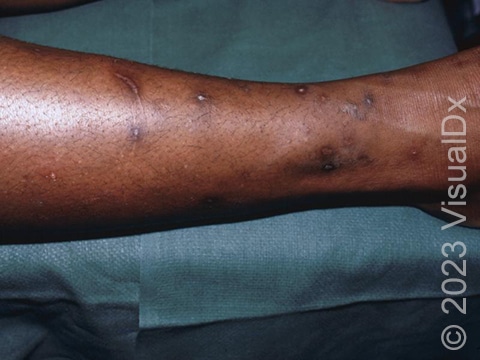Flea Bite
Fleas are bloodsucking insects that live on pets, livestock, and humans. They are small, 1-4 mm in length, and blackish-brown. Although wingless, fleas are capable of taking giant leaps, jumping to a height of several meters. Adult fleas feed only on blood and are capable of going long periods without feeding.
Fleas that live on humans are relatively uncommon. The species that humans are most likely to encounter is the cat flea, which also infests dogs. Humans may also encounter the dog flea or the rat flea. Cat, dog, and rat fleas do not live on people, but they will bite a human if they encounter one and are looking for a blood meal.
Fleas most often bite people around the legs and the ankles. The resulting red papules (small, solid bumps) are an allergic reaction to flea saliva. The bites, which are usually but not always felt immediately, become increasingly irritated and may remain sore and/or itchy for as long as a week. Itching may be just at the site of the bite or may be felt beyond the actual bite site.
Who's At Risk?
Those at higher risk for flea bites include people with household pets, those who work with livestock, and those living in conditions where there is a rodent infestation.
Some people are more sensitive to flea bites than others. Individuals who are very sensitive to fleas may also develop blisters from the bites.
Signs & Symptoms
Flea bites are small, raised, red bumps that are firm to the touch. The redness disappears when pressure is applied. Flea bites can be extremely itchy and may bleed when scratched. Flea bites usually occur around the ankles and lower legs. Other common locations for flea bites include the area around the waist, armpits, creases of the elbows, and behind the knees.
Flea bites produce a variety of effects, ranging from a small, temporary red bump to long-term symptoms that may last for years depending on the sensitivity of the person bitten. The area of skin affected may increase over time, or the rash may spread to a different area. Flea bites can take a very long time to heal and can sometimes evolve into “persistent bite reactions.” Itching and swelling may occur at the sites of older bites when a person is bitten again.
Self-Care Guidelines
To relieve the itching from flea bites, at-home therapies include:
- Calamine lotion.
- Menthol-containing lotions such as Sarna anti-itch lotion.
- 1% hydrocortisone cream.
- Antihistamines such as diphenhydramine (Benadryl) or cetirizine (Zyrtec). Be aware that these may cause drowsiness.
If flea bites have occurred indoors, all sources must be treated for effective flea control. Carpets, pet bedding, and all rooms should be thoroughly vacuumed, and pets should be treated for fleas.
Flea control at home may be regulated by the following measures:
- Bedding should be cleaned and laundered regularly.
- Bedrooms should be vacuumed regularly, especially in the corners and underneath beds.
- The indoor environment can be sprayed with a chemical used for flea infestation.
- A professional exterminator may be needed.
- Pets should be kept clean and regularly checked by a veterinarian.
Flea control for pets includes:
- Oral flea medication (available for dogs but not for cats).
- Monthly topical spot-on products.
- Flea collars.
Treatments
Prescription-strength mid-potency topical corticosteroids can alleviate the severe itch associated with flea bites.
Antihistamines such as hydroxyzine (eg, Vistaril) may be prescribed for the relief of the itching.
Oral antibiotics may be necessary if secondary bacterial infection develops.
Visit Urgency
Seek medical care if:
- Itch is not alleviated using over-the-counter products.
- The bites become infected, such as due to scratching.
- Blisters form in reaction to flea bites.
- Bites do not resolve in a few weeks.
References
Bolognia J, Schaffer JV, Cerroni L. Dermatology. 4th ed. Philadelphia, PA: Elsevier; 2018.
James WD, Elston D, Treat JR, Rosenbach MA. Andrew’s Diseases of the Skin. 13th ed. Philadelphia, PA: Elsevier; 2019.
Kang S, Amagai M, Bruckner AL, et al. Fitzpatrick’s Dermatology. 9th ed. New York, NY: McGraw-Hill Education; 2019.
Paller A, Mancini A. Paller and Mancini: Hurwitz Clinical Pediatric Dermatology. 6th ed. St. Louis, MO: Elsevier; 2022.
Last modified on May 30th, 2023 at 1:39 pm

Not sure what to look for?
Try our new Rash and Skin Condition Finder
